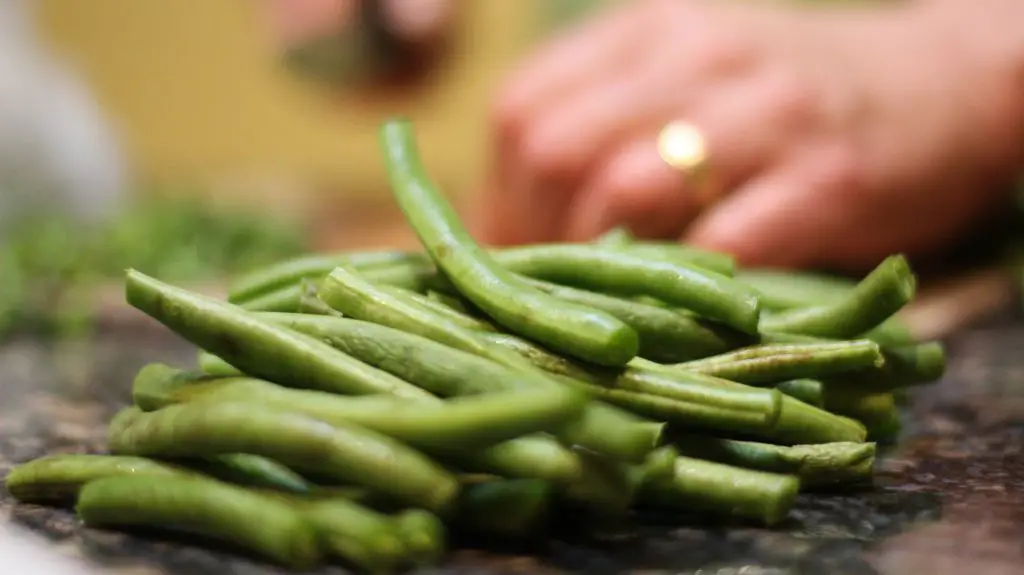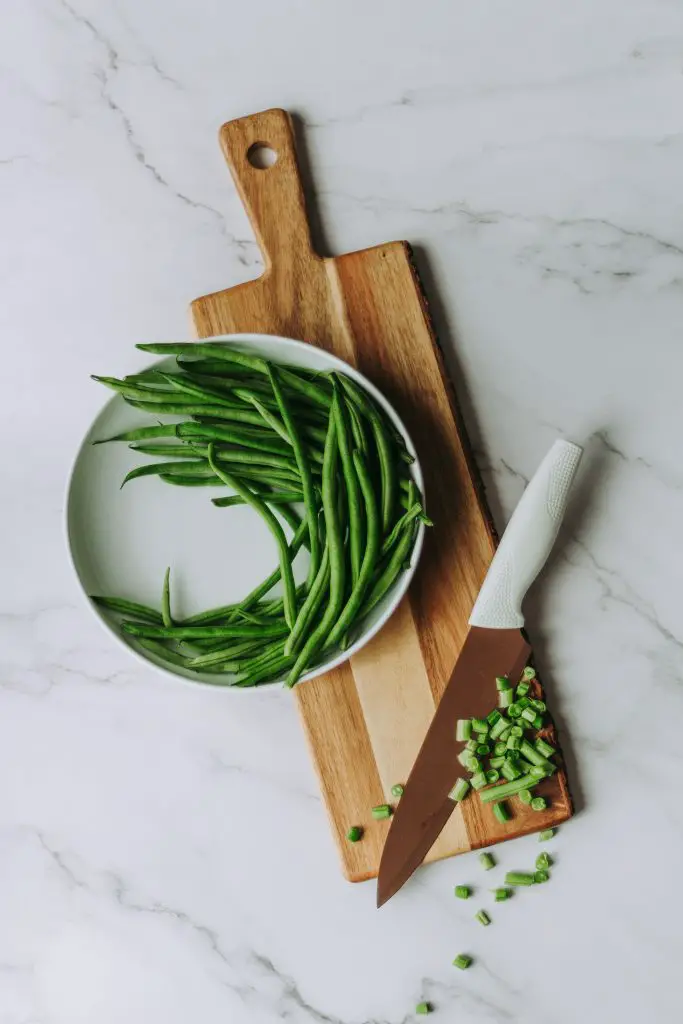How Many Green Beans Does A Plant Produce? Green Beans are one of the most popular vegetables in the world and are used in a broad range of cuisines. It is also one of the easiest vegetables to grow and is highly recommended for beginner gardeners. However, for those that have not grown the vegetable before the obvious question to ask is how many green beans does a plant produce and how many plants do I need to put in?
There are two major types of Green Bean varieties, Bush and Climbing or Pole. Of the two types Climbing or Pole Beans varieties generally produce a higher yield, typically 6 to 7 lbs (2.7 to 3.0 kg) per plant versus 3 to 4 lb (1.4 to 1.8 kg) for bush beans according to the study by West Virginia University.
Other studies from Royal Society of Horticulture in the UK have shown yields for bush beans that are similar to Pole or Climbing varieties. This suggests that there is a degree of variability based on the particular variety selected and the conditions they are grown in. For the purpose of estimating the volume, you need to plant I would assume that you are going to get around 4 to 5 lbs (1.8 to 2.2 kg) per plant.
How Many Green Beans Can I Plant For A Family Of 4?
The number of green beans that you should plant will be dependent upon your usage pattern and whether your plan is to consume beans fresh or attempt to grow enough beans to store for a year for year-round consumption. Generally, I would suggest that you assume that at least a portion of the beans will need to be frozen on the basis that you likely have a glut of beans at some stage during the season.

To calculate the amount required, I have assumed, because you are reading this article that you quite like green beans and would eat them 2 times per week and each time you eat them your family would eat around 10 ounces (300g). The serving size is based on what my own family of 5 eats per meal which is around 12 to 13 ounces (375g).
Based on these assumptions the annual consumption would be around 88 lb (40 kg) per annum. This would require 20 to 22 bean plants. However, as the performance of the plants can be somewhat variable from year to year I would suggest planting 20 to 50% more than what you think you need.
For most people, the limiting factor is their yard size. To give an indication of the space requirements 20 Bush Bean plants would require 15 sqft (1.44 sqm) assuming that you are planting the beans 1 ft (30cm) apart. If you are really tight on space you could use Pole Beans which allow other crops to be interplanted to save space. This is discussed later in the how-to grow beans section.
What is the Best Variety Of Beans To Grow?
According to the study by West Virginia University, the best performing pole bean was Romano however Mountainer produced an earlier harvest. Kentucky Blue was affected by disease in this particular trial but is widely used suggesting that this result is not reflective of its general performance.
| Variety | 7/22 | 7/29 | 8/5 | 8/8 | 8/20 | 8/29 | Total Yield |
| Black Seeded | 0.00 | 0.43 | 2.00 | 0.38 | 3.60 | 0.90 | 7.31 |
| Kentucky Blue | 0.00 | 0.21 | 0.00 | 0.00 | 0.00 | 1.00 | 1.21 |
| Mountainer | 2.23 | 0.37 | 1.52 | 0.43 | 1.30 | 0.93 | 6.78 |
| Romano | 0.17 | 0.80 | 2.72 | 0.92 | 4.17 | 0.26 | 9.04 |
For Bush Beans the harvest of most of the varieties tested was fairly similar with Bountiful producing the highest and earliest yield. See the results below.
| Variety | 8/29 | 9/3 | 9/10 | Total Yield |
| Blue Lake | 0.92 | 2.96 | 0.43 | 4.31 |
| Bountiful | 2.69 | 1.17 | 0.82 | 4.68 |
| Gold Lumen | 0.52 | 2.34 | 0.56 | 3.42 |
| Provider | 1.60 | 1.82 | 0.67 | 4.09 |
| Roc D’or | 2.52 | 0.00 | 0.70 | 3.22 |
Several of the varieties tested are available from Seeds Now in the US which is generally cheaper than many other seed suppliers. Other retailers you might like to try is Seed for Generation or St Clare Seeds. If you live in the UK try visiting Thompson and Morgan, their range is absolutely huge.
How To Grow Green Beans?
Beans are a frost-sensitive plant that thrives in the warmer months of the year. To be successful they need to be planted in the spring after the risk of frost has passed. They can either be sown directly into the soil at a depth of 2 to 3 cm (1 inch) however, I prefer to sow them in seed trays. The benefit of doing this is it allows the seed to be started a little earlier than the first frost, additionally sowing undercover allows you to protect the beans from pests.
When sowing in trays it will take around 4 to 6 weeks before the plants are big enough to be planted out into the garden. At this point, it is a good idea to protect the plants from slugs and snails by sprinkling snail pallets around the seedlings. There are many different brands of snail pallets that can be purchased from Amazon.
When planting the seedlings out into the garden the plants should be spaced 25 to 30 cm (10 to 12 inches) apart in a warm sunny spot as they need at least 6 hrs of sun a day. Ideally, the soil should be moist and well-drained with plenty of organic matter. The method I use to prepare the soil is the No Dig method as it is quick, easy and reduces the volume of work in the garden significantly.

The No-Dig method only requires a thick layer of compost, 5 to 10 cm (2 to 4 inches) to be applied once a year. The layer of compost serves to feed the soil and also it acts as a mulch. To learn more about this technique click here.
If you are growing Pole Beans (climbing beans) it will be necessary to erect a support structure that is around 2.0 m (6 to 7 ft) tall. This is often done with bamboo canes or hazel rods. However, there are also commercially available systems that can be purchased through Amazon that also work quite well. The beans will generally climb up the structure by themselves, however, occasionally it may necessary to tie them into the structure.
From the date of sowing Beans typically take 80 to 90 days to start producing pods that can be picked. Once the plants start to crop it is best to pick the beans as soon as they are ready because the pods will become tough over time. Additionally, it is best to pick the Beans frequently as consistent harvesting will also encourage the plant to continue to flower extending the growing season.
If you chose to plant Pole Beans rather than Bush Beans their growing habit allows them to be underplanted with other vegetables that prefer a little shade in the height of summer. This typically includes leafy crops such as lettuce and silverbeet.
Beans are also suitable to grow with a range of crops which include;
How To Store Green Beans
It is almost enviable that at some point during the growing season you will have a glut of Beans. And while it is possible to store Beans for about 2 weeks in the fridge you find that once the beans get going you have to start to think about longer-term storage.
The most obvious option is to freeze the Beans however, this will require you to blanch the beans. The process of blanching will stop enzyme activity within the Bean preventing it from degrading when frozen.

For those unfamiliar with blanching it requires the beans to be placed in boiling water for a short period of time, to prevent the loss of flavour, colour, and texture when frozen. The steps on how to do this are provided below;
- Step 1: Wash the Beans and remove the ends.
- Step 2: Submerse the Beans into a large pot of boiling water for 2 minutes.
- Step 3: Stop the cooking process by removing the beans from the boiling water and immediately plunge them into the ice water to cool, for around the same amount of time as the blanching, and then drain thoroughly.
- Step 4: Pack the Beans into containers to freeze. Resealable plastic bags, or tupperware containers are ideal for this purpose. Ensure each bag or container is labelled with dates.
An alternative to freezing beans is to pickle them. This method really enhances the beans’ flavor. There are numerous pickling recipes available on the internet, below is an example of a fairly typical recipe.
Ingredients
- 5 ounces of green beans
- 1 clove garlic
- 1/2 teaspoon coriander seeds
- 1/2 cups vinegar
- 1 cup water
- 1 tablespoon sugar
- 1 teaspoon salt
Method
- Step 1: Wash the Beans and Remove Ends
- Step 2: Place the Beans in a Sterilised Jar. When packing the beans into the jar you may choose to pack the beans vertically or cut them into smaller pieces. If you choose to pack them upright it will necessary to trim them to fit, leaving at least 1/2 inch of headspace at the top of the Jar.
- Step 3: Peel the garlic and slice it into fine pieces. Place the garlic in a saucepan.
- Step 4: Add the remaining herbs, vinegar, water, sugar and salt to the saucepan and bring it to the boil for 5 minutes
- Step 5: Pour the hot mixture over the beans. The liquid should completely cover all of the beans.
- Step 6: Screw on the lid and let the jar sit until it has cooled to room temperature. Store in a cool dark place.
If you want to give your preserves away to friends as a present you may consider purchasing decorative jars. There is a wide range of jars that will make your preserves look extra special available on Amazon.
Relevant Article
What Is The Difference Between Dwarf Beans and Climbing Beans?
Are Bush Or Pole Beans Better?
How Long Does It Take For Green Beans To Germinate? How Does Temperature Effect It?
How Do You Make A Support For Sweet Peas?
